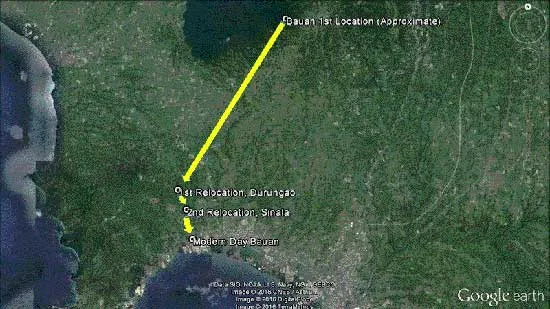The Original Locations of Some of Batangas' Towns and Cities
This article shows where the cities of Lipa and Tanauan along with the Municipalities of Bauan, Rosario, San Juan and Taal were once originally located as humble little settlements and how they moved over time.
These present day geopolitical units were chosen for inclusion in this article first because of the availability and reasonable believability of material about their movements over the Internet; and second since the movements were significant enough over time to be worth writing about. Batangas City, for example, began and grew from where it is still basically located. Thus, the city is not included.
Bauan
Bauan in the 16th century was at the foot of Mt. Maculot close to Taal Lake. In 1662, the settlement was transferred south to Durungao, which we assume to be the barangay or village that is part of modern day Bauan. In 1671, the settlement was relocated again to a place called Sinala, which we again assume to be the village also part of modern day Bauan. The last relocation of Bauan to where it continues to be in the present was done in 1690. (Bauan official web site)
Lipa City
The lakeside village of Tagbakin, presently part of Lipa City, was in 1605 supposedly the first settlement of Malays who would subsequently become Lipeños. The inhabitants of the settlement fled to Lumang Lipa, presently a village part of the Municipality of Mataas-na-Kahoy, in 1724 because of the Taal Volcano eruption. They stayed until 1754 when the entire settlement again had to relocate to what is not present day Balete. Two years later, the settlement was on the move again to the city’s present day location basically as a precaution against more volcanic eruptions. (Wikipedia)
Rosario
The Municipality of Rosario is thought to have begun as a Christian settlement along the coast of what is now the Municipality of Lobo. Pirate raids in the 18th century forced the settlers inland to what is now the Municipality of Taysan and later to present day Padre Garcia. When the town which grew from the second relocation was flattened during WWII, the American military command transferred it to what is presently Poblacion Rosario. (Wikipedia)
San Juan
San Juan, which used to be a barrio of Rosario, is believed to have been originally closer to the sea and likely in the vicinity of its present day village called Pinagbayanan. Floods in 1886 forced the relocation inland of the entire village to what is likely the present day village of Calitcit. From thence likely grew modern day San Juan, which is a mere stone’s throw away from the center of town. (Wikipedia)
Taal
The Municipality of Taal was founded by a Spanish priest named Diego Espinas in 1572 along the coastal settlement of Balangon, which we assume to be the same village which is presently a barangay or village of the Municipality of Agoncillo. After raiding Moros razed down the settlement in 1575, Espinas led the entire population to relocate to what is presently known as the Municipality of San Nicolas. The volcano’s violent eruption in 1749 forced inhabitants to relocate once more to its present location. (Taal Heritage Town)
Tanauan
Tanauan is believed to have been evolved from settlements called Tanauan and Sala founded by Augustinian friars on the shores of Taal Lake in the 16th century. The volcanic eruption of 1749 destroyed the settlements, which forced the survivors to relocate first to what is presently Bañadero and then subsequently to what is present day Tanauan City. (Wikipedia)
Notes and references:
The information contained in this page was taken from various sources.






